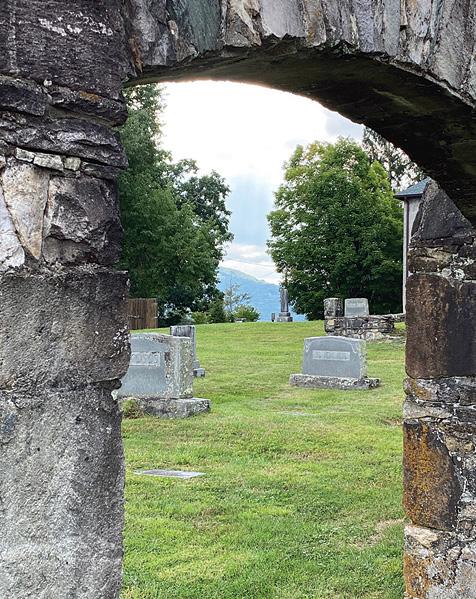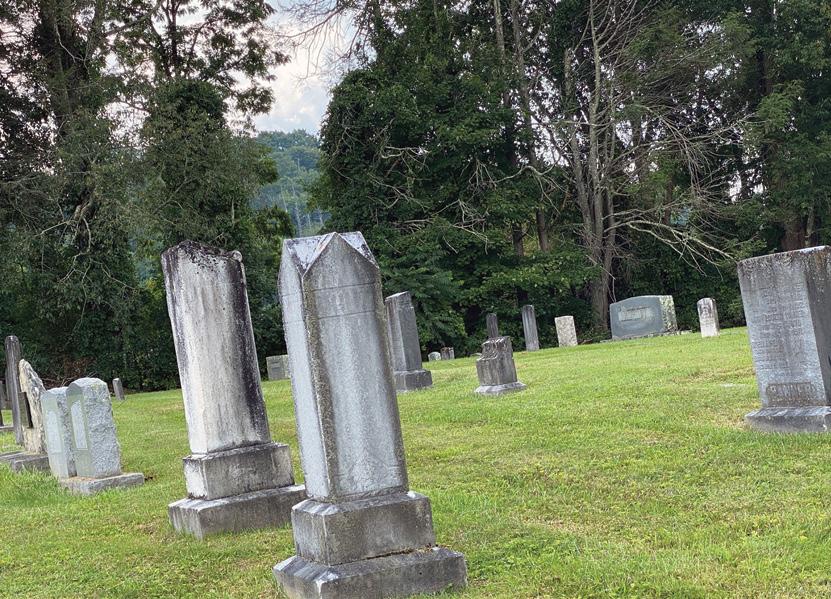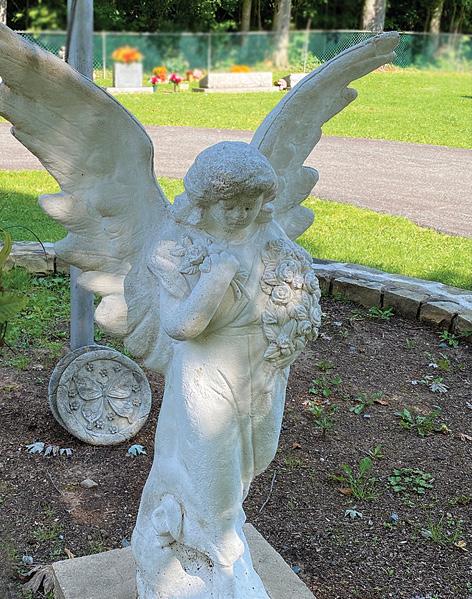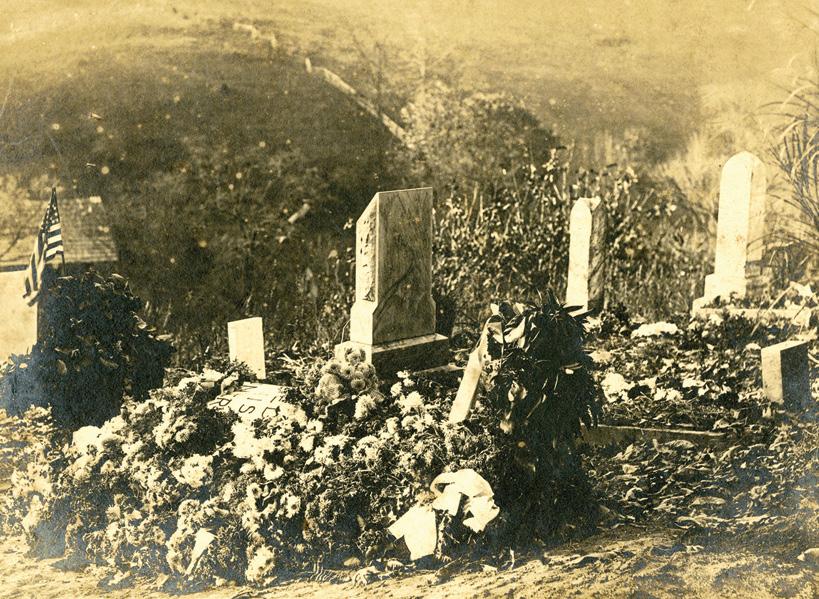
6 minute read
Historic Cemeteries | By Elizabeth Baird Hardy

A Surprisingly Lively Destination:

Visiting the Past Safely at a Historic Cemetery
By Elizabeth Baird Hardy
During the nineteenth century, when most of our great public cemeteries were established, the prevailing idea was that cemeteries should be more than merely final resting places for the deceased: they should be places of reflection, meditation, and even recreation. Often we have lush, park-like settings with birdbaths, benches, and winding pathways. Sometimes, these became parks with graves scattered throughout them, providing much-needed green space.
Today, we don’t often think of cemeteries as great places to visit. After all, we are not Victorians, for whom mourning was a lifestyle choice rather than a temporary condition. In our region, cemeteries are more often church, or family, plots than the sweeping expanses of places like Oakwood in Richmond, Virginia, or Bonaventure in Savannah, Georgia. Yet, the cemeteries here can also be fascinating places to visit, with opportunities to learn about the past and enjoy our present.
Who goes to Cemeteries? Everybody!
A historic cemetery, whether large or small, offers many incentives to different kinds of visitors. For the natureseeker, these sites can provide a peaceful spot to enjoy plants and trees, along with the occasional squirrel. Graves are sometimes bedecked with beautiful shrubs, antique rose bushes, or other botanical specimens planted long ago. Many of our region’s older cemeteries occupy hillsides, so the view is often spectacular. A quiet, windswept vista frequently awaits those who trek up the slopes of our older cemeteries. For the art-lover, cemeteries are galleries in stone, presenting a wide variety of beautiful carving and artwork. The study of tombstone art is called taphography, and sends many practitioners to older burying grounds. Whether you are a novice who just likes seeing the carved angels and urns, or an expert in the symbols and themes presented on tombstones, a historic cemetery provides a wealth of opportunity to view gravestone art. To learn more about the symbols one might find in our regional burying grounds, you would do well to consult Stories in Stone by Douglas Keister, or Sticks and Stones by Ruth Little. Many of the simplest carvings have a great depth of meaning, from the pointing fingers to the broken chains, and there are many examples of both popular and unique motifs. A large, urban cemetery may have more to offer in terms of impressive statuary, but stones in our region have their own artistry and unique style. For example, the Bear Creek Baptist Church Cemetery boasts the impressive and unique pyramid of Professor Wing, who was committed to education in Mitchell County early in its history. Other headstones are striking for their homemade simplicity.
Preserving the past is a central reason why people visit old cemeteries. When we walk among the graves, we learn much about history. A number of famous individuals are buried in our area: from the nephew of Benjamin Franklin, buried in the Pisgah United Methodist Church in Crossnore, to the notorious Keith and Malinda Blaylock, who both served in both the Union and Confederate armies, and who are buried in the Montezuma Cemetery.
Many people who visit cemeteries do so to learn about their own families as they search for the graves of ancestors. But the graves of strangers can also be educational. Even children can learn from a cemetery visit. They can see how short lives could be in the past, and even notice trends, such as a number of graves from the same times, marking a war or an epidemic like the tragic 1918 Spanish Influenza outbreak. We can better understand how people saw the world, as the stones declare their feelings about life, death, and faith. For example, a number of stones have typical nineteenth-century statements that we might find morbid today, such as, “As I once was, so you are now. As I am now am, so you will be.” We can learn about common beliefs like the value placed on


Right: Photographer Unknown, “Henson Chapel Methodist Church Cemetery,” Digital Watauga, accessed August 24, 2021, https://digitalwatauga.org/items/show/18859.
children and on honorable military and civic service. Stones can also tell us about individuals with their own unique view on life and how they were regarded by those they left behind.
Honoring those who have gone before us is one of the most noble reasons to visit a historic cemetery. Some gravesites are sorely neglected because no one is left to care for them, but even a cemetery that is mowed regularly may have few affectionate visitors. When we visit an old cemetery there is something uplifting about putting a few daisies in the stone flowerpot that has clearly not had flowers in years. Those who visit cemeteries can take a few moments to remember, and thus, honor, people who have no descendants nearby to come visit. Many veterans’ graves are marked with flags and flowers by those who are no relation to them whatsoever, but who simply want to respect their service and preserve their memory.
Historic Cemeteries Are Everywhere
In Appalachia, most cemeteries were created around churches or as family plots. There are public cemeteries as well, such as Boone’s cemetery and the remarkable Riverside in Asheville. Those who simply want to visit a historic cemetery, regardless of who inhabits it, may want to start by checking out maps or other resources. Topographical maps, which usually include many of the lesstraveled roads, will show cemeteries, as do Google maps and other online sources. It is important to remember that some cemeteries are off the paved road and can only be reached with four-wheel drive or even on foot.
Some of the most wonderful cemetery visits result from just seeing a small church surrounded by graves and taking the time to stop. While there are many cemeteries on private property, and others that may be hard to reach, there are many, many others that are on the beaten track and easy to visit. A few of the best ones in our area are Academy Hill in Burnsville, Bear Creek Baptist Church in Ledger, and St. Paul’s Episcopal Church in Wilkesboro, but every cemetery has a story.
Mind Your Manners
Even though most cemetery visits are recreational, it is essential that the sites are treated respectfully. Never enter a cemetery on private property without permission. Avoid contact with tombstones. Touching the stones is unhealthy for the stones themselves as well as for humans. Human skin oils can damage stones that are hardly marked by rain or snow. Repeated touching can wear down already fragile inscriptions or carvings and make them illegible for future visitors to enjoy. In addition, stones can be sharp or abrasive, so hands off is best.
Pets are forbidden by most cemetery regulations, but they can also present dangers and distractions to visitors. In addition, many cemeteries still have active sections, so it is important to be sensitive to those who are there to pay respects. In other words, if there is a funeral going on three rows over, it’s probably a bad idea to start yelling, “Hey, there’s a guy over here who was killed at Gettysburg!” Although the Victorians did take picnic lunches to cemeteries, that practice is generally frowned on today. It is also essential to avoid littering or causing other damage.
Even though we may not immediately think of the cemetery as the first place to go for a breath of fresh air, or an art and history lesson, these beautiful spots, once the sites of grief, can provide peaceful and safe places for these experiences. It’s no small irony that a cemetery can be a wonderful place to celebrate life.











